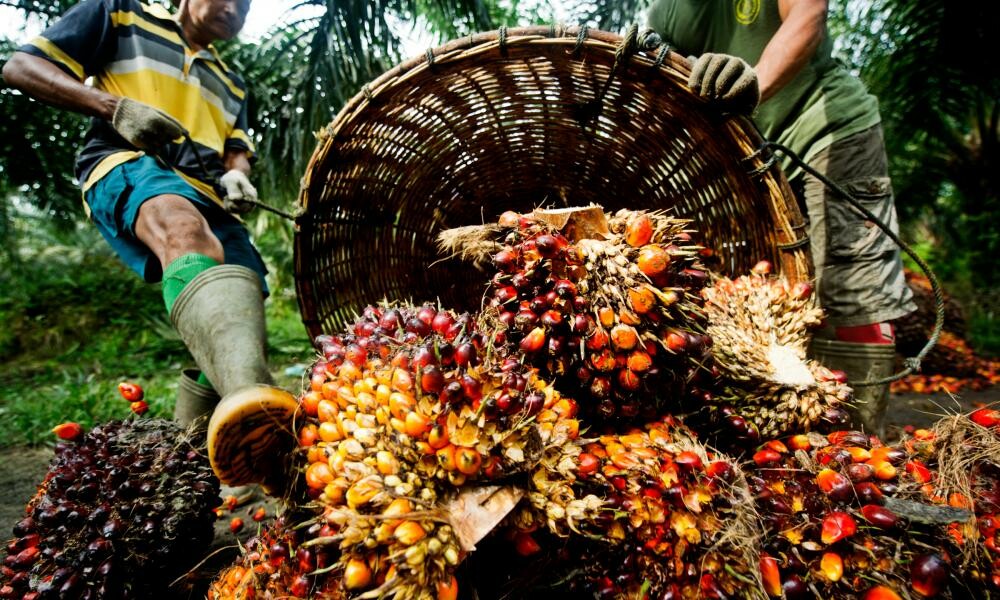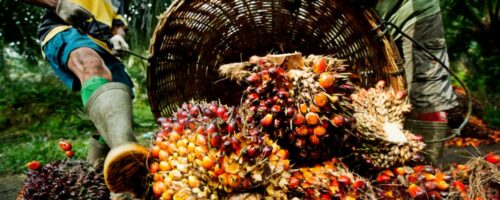
Southeast Asia
How is it produced?
Palm oil is contentious due to the complicated political entanglements, as well as a variety of environmental and social harms. The growth and cultivation of the oil palm plant requires low biodiversity coupled with high deforestation, has posed a risk to animals native to Indonesian and Malaysian forests, has necessitated the coercion Indonesian Indigenous populations, and has resulted in precarious lives for migrant workers and their families (Gatti et al, 2018; Gatti et-al, 2020; Holzner et-al, 2021; Pruder, 2019; Urano, 2020). There have been small- and large-scale efforts to improve sustainability and hold businesses or growers accountable, but they are made complicated by the influence held by corporations and by the governments of Indonesia and Malaysia, as well as a lack of cohesion amongst smaller-scale initiatives (Gatti et al, 2018; Gatti et-al, 2020; Dauvergne, 2018).
There are two types of palm oil: crude palm oil and palm kernel oil, which require squishing the palm fruit for crude, and crushing the palm fruit’s pit for kernel oil (World Wildlife Fund, n.d.).
Describe the supply chain to the store shelf in Canada:
Palm oil ends up on store shelves in Canada from multinational corporations putting it into their products; for example, the multination company Upfield sources palm oil from various parts of the world to put into products like margarine (Upfield, 2020).
What is the power balance between the producer and seller?
Indigenous peoples in Indonesia are often with no or little amenities like electricity or running water, so they are willing to allow development on their land for the hope of a better economic situation (Urano, 2020). In Malaysia, migrants with no or flimsy documentation are often tasked to work the most gruelling jobs in the palm oil sector, with only enough pay to buy minimal necessities (Pruder, 2019). The demand for palm oil strains those living in the countries in which palm oil is grown, and a clear power dynamic can be seen as the underprivileged in either country often feels a necessity to accept harsh conditions, pollution, and oppression, in order to maintain any sense of economic security.
There have been large-scale efforts at sustainability, but they are not without difficulty. Efforts come largely in the form of the Roundtable on Sustainable Palm Oil, a collective of NGO’s and multinational corporations who work to make official guidelines on what can be considered a sustainable palm oil practice. One criteria of the RSPO is that locals are able to give free, prior, informed consent, meaning that local populations are given all information required to make a decision on whether to allow oil palm cultivation on their land (RSPO, 2018). In spite of the aforementioned criteria, the RSPO has given the sustainability label to forests which were severely depleted of diversity before the RSPO criteria came into effect, and the concept of FPIC is weak given the imbalance of power which forces locals to allow development in order to find some form of financial stability. (Gatti et al., 2018; Hasudungan & Neilson, 2020). In addition, populations who have refused development have experienced water pollution due to runoff from villages who accepted development (Urano, 2020).
Indonesia and Malaysia both have their own state-sponsored media and sustainability agencies, who assure the public that palm oil cultivation is friendly to the environment and good for the economy, and who accuse scientists, academics, and NGO’s of lying in order to harm either countries’ sovereignty (Liu et al., 2020; Pacheco et al., 2018).
Can you recommend changes to the system to improve the balance?
Given that the RSPO has labelled forests as sustainable when they are anything but, and that marginalized groups are at the mercy of their poverty, it is clear that palm oil still has a long way to go until it is non-exploitative. Moving forward, it could be beneficial for the RSPO to re-assess some of the certifications of sustainability it has given, for the Indonesian and Malaysian governments to provide more honest information on palm oil, for corporations to recompense populations affected by palm oil-related pollution, more power to smallholding farmers, and a look into alternative vegetable oils if they can provide better sustainability for certain palm-reliant products.
References/Resources:
Dauvergne, P. (2018). The global politics of the business of “sustainable” palm oil. Global Environmental Politics, 18(2), 34-52. doi.org/10.1162/glep_a_00455.
Gatti, R.C., Liang, J., Velichevskaya, A., & Zhou, M. (2018) Sustainable palm oil may not be so sustainable. Science of the Total Environment, 652(2019), 48-51. https://doi.org/10.1016/j.scitotenv.2018.10.222.
Gatti, R. C. & Velichevskaya, A. (2020). Certified “sustainable” palm oil took the place of endangered Bornean and Sumatran large mammals habitat and tropical forests in the last 30 years. Science of the Total Environment, (742)2020, 1-6. https://doi.org/10.1016/j.scitotenv.2020.140712.
Hasudungan, A., & Neilson, J. (2020). Processes of land appropriation for large-scale oil palm development in West Kalimantan, Indonesia. Revista NERA, 23(51), 366–389. https://doi-org.ezproxy.tru.ca/10.47946/rnera.v0i51.6542
Holzner, A., Balasubramaniam, K. N., Weiß, B. M., Ruppert, N., & Widdig, A. (2021). Oil palm cultivation critically affects sociality in a threatened Malaysian primate. Scientific Reports, 11(1), 1–16. https://doi-org.ezproxy.tru.ca/10.1038/s41598-021-89783-3.
Liu, F. H. M., Ganesan, V., & Smith, T. E. L. (2020). Contrasting communications of sustainability science in the media coverage of palm oil agriculture on tropical peatlands in Indonesia, Malaysia and Singapore. Environmental Science and Policy 114(2020), 162-169. https://doi.org/10.1016/j.envsci.2020.07.004
Morgan, J. (n.d.) [Workers with basket of palm fruit] [Photograph] WWF-UK. https://www.wwf.org.uk/updates/8-things-know-about-palm-oil
Pacheco, P., Schoneveld, G., Dermawan, A., Komarudin, H., & Djama, M. (2018). Governing sustainable palm oil supply: Disconnects, complementarities, and antagonisms between state regulations and private standards. Regulation & Governance, 14(3), 568-598. https://doi.org/10.111/rego.12220.
Pruder, J. (2019). Excluding migrant labor from the Malaysian bioeconomy: Working and living conditions of migrant workers in the palm oil sector in Sabah. Austrian Journal of South- East Asian Studies, 12(1), 31-48.
RSPO. (October 2008). Free, prior and informed consent and oil palm plantations: A guide for companies. Retrieved from https://www.rspo.org/files/resource_centre/FPIC%20and%20the%20RSPO%20a%20gui de%20for%20companies%20Oct%2008%20(2).pdf
Upfield (May 2020). Sustainable palm oil sourcing. Retrieved from https://upfield.com/wp- content/uploads/2021/01/Our-sustainable-palm-oil-sourcing-policy.pdf
Urano, M (2020). Why the principle of informed self-determination does not help local farmers facing land loss: a case study from oil palm development in East Kalimantan, Indonesia. Globalizations 17(4), 593-607. https://doi.org/10.1080/14747731.2019.1654703.
World Wildlife Fund (n.d.). Which everyday products contain palm oil?. Retrieved from https://www.worldwildlife.org/pages/which-everyday-products-contain-palm-oil

